The engine shutdown detection mechanism simplifies your ORION-Tr DC-DC Charger system by detecting if the engine is running without wiring additional switches or sensors. The factory default setting will work with most regular and smart alternators but can be re-configured with the VictronConnect App.
Configuring the engine shutdown detection depends on the voltage the alternator generates when the engine is running. Regular alternators generate a fixed voltage (e.g. 14V), whereas smart alternators generate a variable output voltage ranging from 12.5V to 15V. Especially smart alternators in a regenerative braking system show significant alternator voltage variations.
Engine shutdown detection is only active in charger mode. The feature can be disabled by the “engine shutdown detection override” and in VictronConnect. In power supply mode, the “input voltage lock-out” determines when the output is active.
Note
The engine shutdown detection is updated from software version v1.05 onwards.
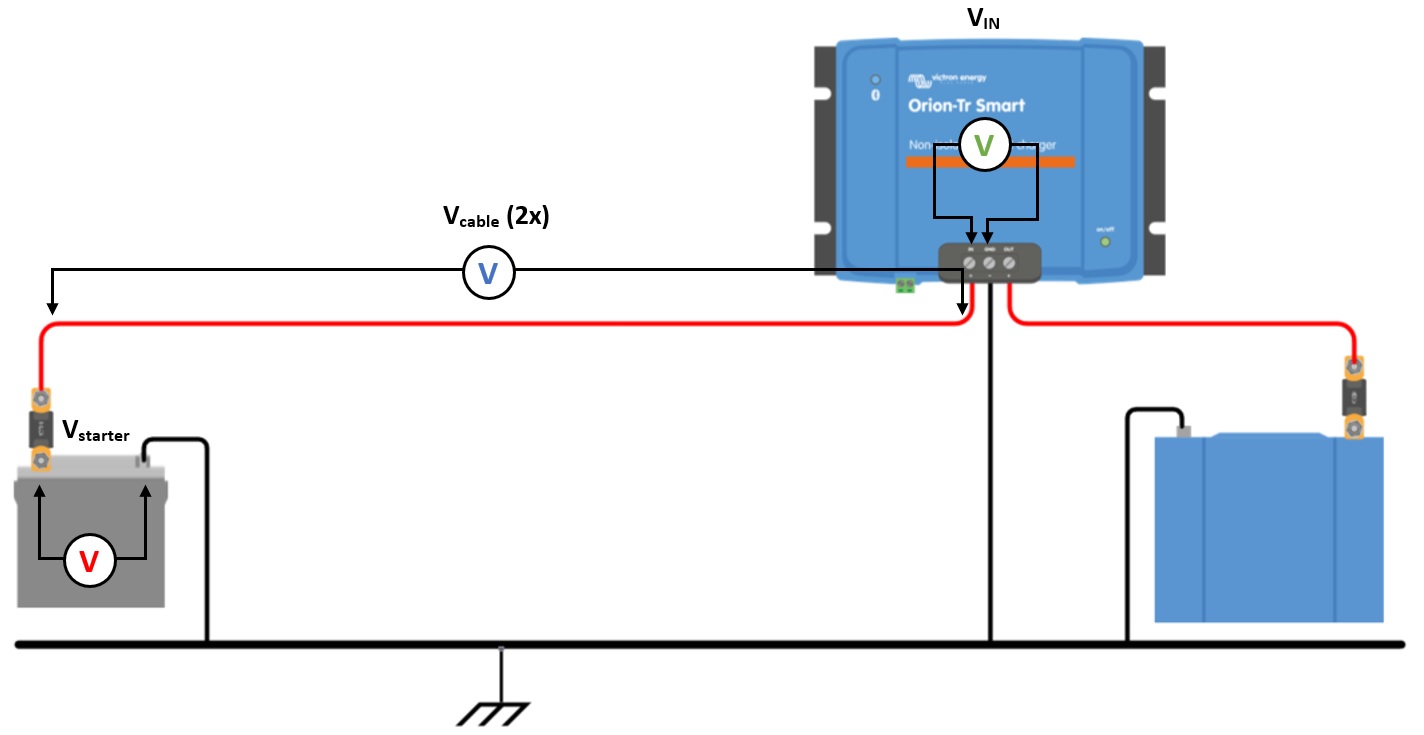 |
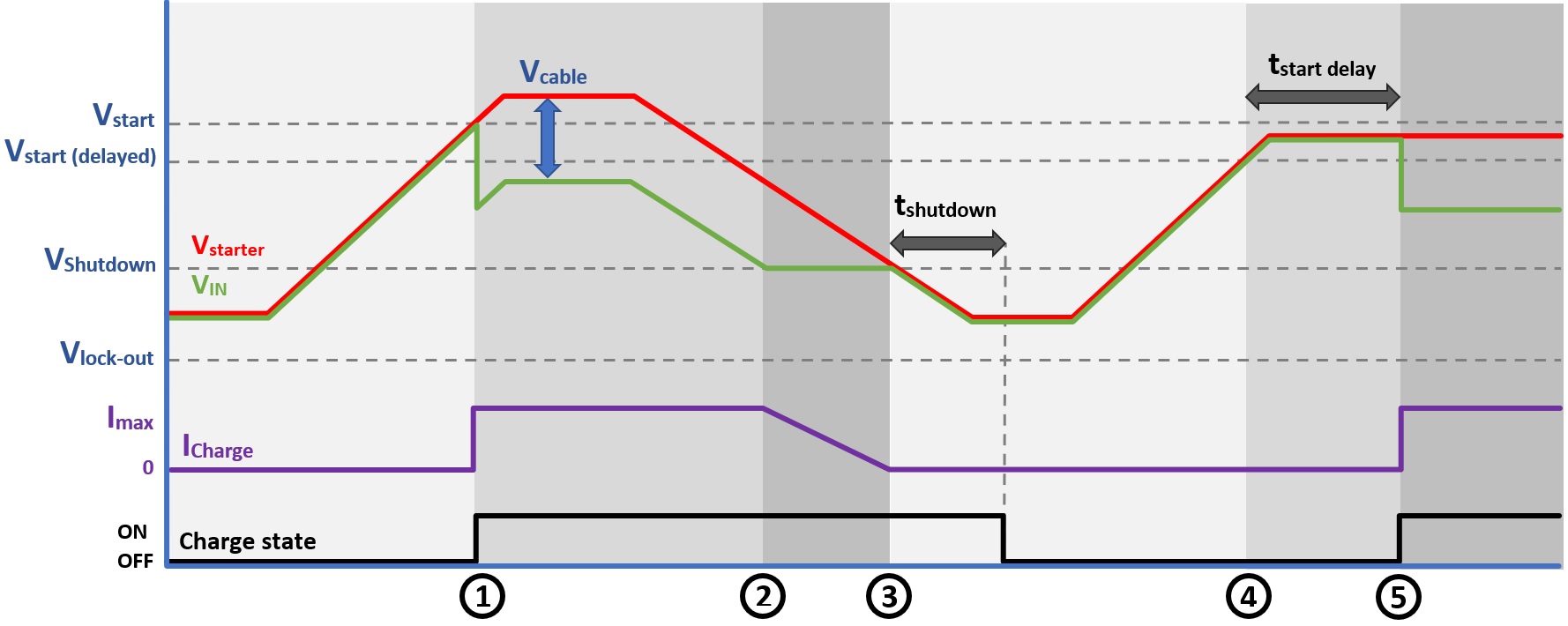 |
Figure 8: Engine shutdown detection sequence
0 → 1: If the engine runs the alternator voltage will ramp-up, when Vstarter > Vstart, charging is enabled.
1 → 2: The input current produces a voltage across the input cable (Vcable); this voltage reduces the voltage measured by the charger (VIN). If VIN > Vshutdown the charger will operate at Imax.
2 → 3: If VIN ≤ Vshutdown, the charge current will be reduced to prevent VIN to drop below Vshutdown.
3 → 4: If VIN < Vshutdown for longer than 1min (tshutdown) “engine off” is detected and charging is disabled. If VIN > Vshutdown before tshutdown runs out, charging remains enabled.
4 → 5: If Vstart(delay) < VIN < Vstart charging is enabled after tstart delay (configurable).
Open VictronConnect and press the cog symbol  to enter the settings.
to enter the settings.
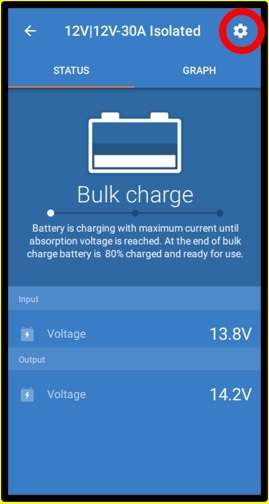 | 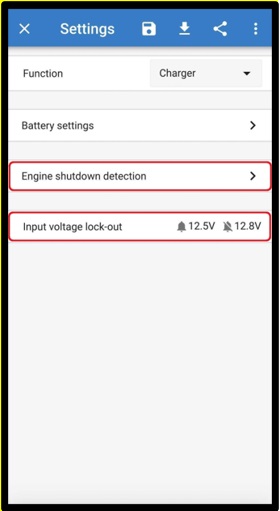 | 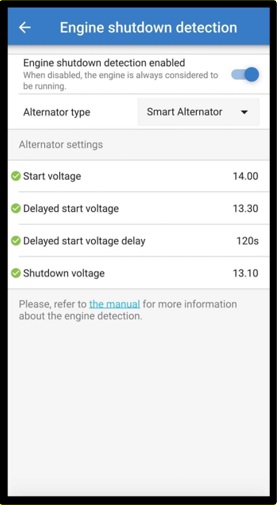 | 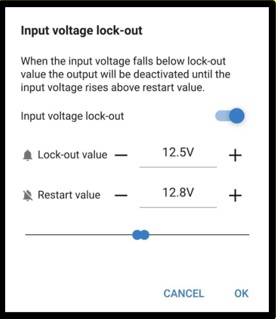 |
Figure 9: Engine shutdown detection setup menu
The following settings can be changed with VictronConnect:
Notice
The default values displayed are for 12V input models. These values are scaled based on the model's input voltage. For example, for 24V input models, the default values in the manual should be multiplied by 2, and for 48V models, they should be multiplied by 4.
Engine shutdown detection enabled: The engine shutdown detection is always enabled by default when the charger mode is selected. When it is disabled by the user or when power supply mode is selected, the engine is considered to be running, so no shutdown detection will take place.
Alternator type: The alternator type can be selected between “Smart Alternator”, “Regular Alternator”, and “User defined”. When the “Smart Alternator” option is selected, the default values for the smart alternator are/will be applied to the engine shutdown detection settings. The same will happen when the “Regular Alternator” option is selected. When any settings differ from the default values of the last two options, the “User defined” option will be selected. Default: “Smart Alternator”.
Start voltage (Vstart): At this level, charging starts immediately. Default: 14V.
Delayed start voltage (Vstart(delay)): Smart alternators can generate a lower voltage when the engine is running; therefore, a lower start level is necessary for these systems. To ensure that the starter battery is recharged after starting the engine, charging of the auxiliary battery is delayed during this condition. The energy used during starting must be replenished to ensure that the starter battery remains properly charged. Default: 13.3V (Smart Alternator) and 13.8 (Regular Alternator).
Delayed start voltage delay (tstart delay): Recharge time for the starter battery during start level (delayed). Example: If the starter draws 150A for 5sec to start the engine, about ~0.2Ah is drawn from the starter battery. If, during engine idling, the alternator can only generate 20A, it takes 150A/20A x 5sec =37.5sec to recharge the starter battery. Default: 2 minutes.
Shutdown voltage (Vshutdown): This level corresponds with the engine being off. This keeps the starter battery fully charged and provides a hysteresis with respect to the start level. The hysteresis must be large enough to prevent VIN to drop to Vshutdown , which would result in charge current reduction. Action will be taken after tshutdown runs out (1 minute); this allows charging during temporary low voltage conditions. Default: 13.1V (Smart Alternator) and 13.5V (Regular Alternator).
Range for engine start/shutdown levels:
12|12; 12|24; 12|48: 8 to 17V
24|12; 24|24; 24|48: 16 to 35V
48|12; 48|24; 48|48: 32 to 68V
Setup input voltage lock-out: Input voltage lock-out is the minimum level at which charging is allowed; below this level, charging stops immediately. Default (in charger mode): lock-out: 12.5V / restart: 12.8V. Default (in power supply mode): lock-out: 10.5V / restart: 12V.
Warning
When ‘forced charging’ is enabled, current will be drawn from the starter battery if the engine is not running. Setting the lock-out level very low can result in a depleted starter battery.
To set up input voltage lock-out, two criteria are important:
Minimum alternator voltage: A smart alternator can operate at very low alternator voltage (<12.5V), e.g. when the vehicle accelerates. This low voltage is allowed during tshutdown as shown in “engine shutdown detection sequence 3→4”. If charging must remain enabled during this period, the lock-out level must at least be set below the minimum alternator voltage.
Notice
If the low voltage period exceeds tshutdown charging will be disabled on engine shutdown detection.
Voltage drop across the input cable: As seen in “engine shutdown detection sequence 1→3”, VIN will be lowered by Vcable. When the alternator voltage drops fast (smart alternator), the charge control needs some time to reduce the charge current and keep VIN at Vshutdown. During this time Vcable must not trip the voltage lock-out. Therefore, the lock-out value should be: Vlock-out ≤ Vshutdown – Vcable.
Example: Calculate the input cable voltage drop:
Distance between starter battery and charger: 5m.
Vshutdown= 13.1V. Recommended wire gauge: 16mm2.
Cable resistance: ~1.1mΩ/m @20°C, thus Rcable = 1.1mΩ x 10m (2x 5m) = 11mΩ.
A 12|12-30A Smart Charger will draw about 35A from the input when running at full capacity, resulting in:
Vcable = 11mΩ x 35A = 385mV.
Vlock-out ≤ Vshutdown – Vcable = 13.3V – 385mV ≈ 12.9V.
Notice
Cable connections, external fuses, temperature, etc., influence the total cable resistance.